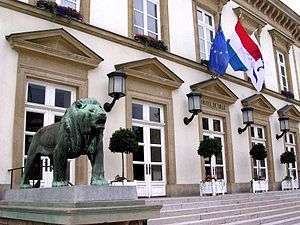Auguste Trémont

Auguste Nicolas Trémont (31 December 1892 – 23 October 1980) was a Luxembourgian sculptor. He specialised in sculptures of animals, with a particular emphasis on big cats.
Life
After spending his childhood in Luxembourg, Auguste Trémont moved to Paris where he enrolled at the Ecole des Arts décoratifs in 1909. World War I caught him by surprise while he was visiting Luxembourg. As he tried to make his way back to Paris by passing through Switzerland, he was arrested by German forces near the Swiss border and was imprisoned. Once released from detention, he returned to Luxembourg where he remained until the end of the war in 1918, working in a steel factory in Dudelange. This work gave him the opportunity to practice his skills by drawing pictures of steel workers in action; he also befriended future Arbed president Aloyse Meyer.
At the end of the war, Trémont returned to Paris where he studied at the Ecole des Beaux Arts. He first specialized in portraits and pictures of Paris. This changed when he visited the Jardin des Plantes, the zoological gardens, where he found the subjects that were to become his main area of specialization: animals. Later in his life, when asked why he chose to represent animals, he replied: “because it was the most difficult task”.
In 1924, Trémont made his first sculptures, and he subsequently developed his skills as a sculptor by creating animal sculptures in a variety of sizes and species. The late 1920s-early 1930s were his most productive years; it is during this period that he sculpted, in Paris, two large lions that now decorate the entrance of the Luxembourg City Hall. He spent World War II in Paris, and returned to Luxembourg at the end of the war where he created monuments for the victims of the war.
Trémont's work was made available to the public through the Ruhlmann art gallery, then later Edgar Brandt and Malesherbes art galleries. His work is also represented on numerous Luxembourgian stamps.
Major works
Works by Trémont adorn some of the most prominent buildings in his hometown of Luxembourg City, including Notre-Dame Cathedral and Luxembourg City Hall. He also created sculptures for the Luxembourgian pavilions at the Brussels 1935 and Paris 1937 World's Fairs.
- 1924: Chimpanzee
- Panther, Couple of Royal Tigers
- 1926-1932: Black Panther, Turning Panther, Serval, Tiger, Elephant, Walking Tiger, Lion, Bison
- 2 lions (Luxembourg City town hall)
- 1932: Côte d'Ivoire Dwarf Buffalo
- Couple of Royal Tigers, Stag (purchased by the City of Paris)
- 1935: Miners (Luxembourgian pavilion of the Brussels World Fair)
- 1936: Religious scenes (Luxembourg Cathedral)
- 1937: Hind (Luxembourgian pavilion of the Paris World Fair)
- 1945: Liberation medal
- Monument to the Dead (Differdange)
- Monument to Dead Soldiers
Prizes
- 1918: Prix Grand-Duc Adolphe
References
Auguste Trémont, Le grand Animalier, in Les Cahiers luxembourgeois, 1993